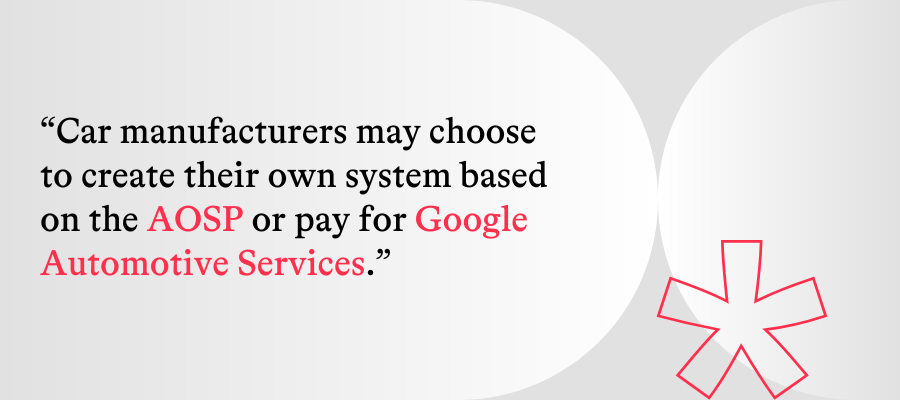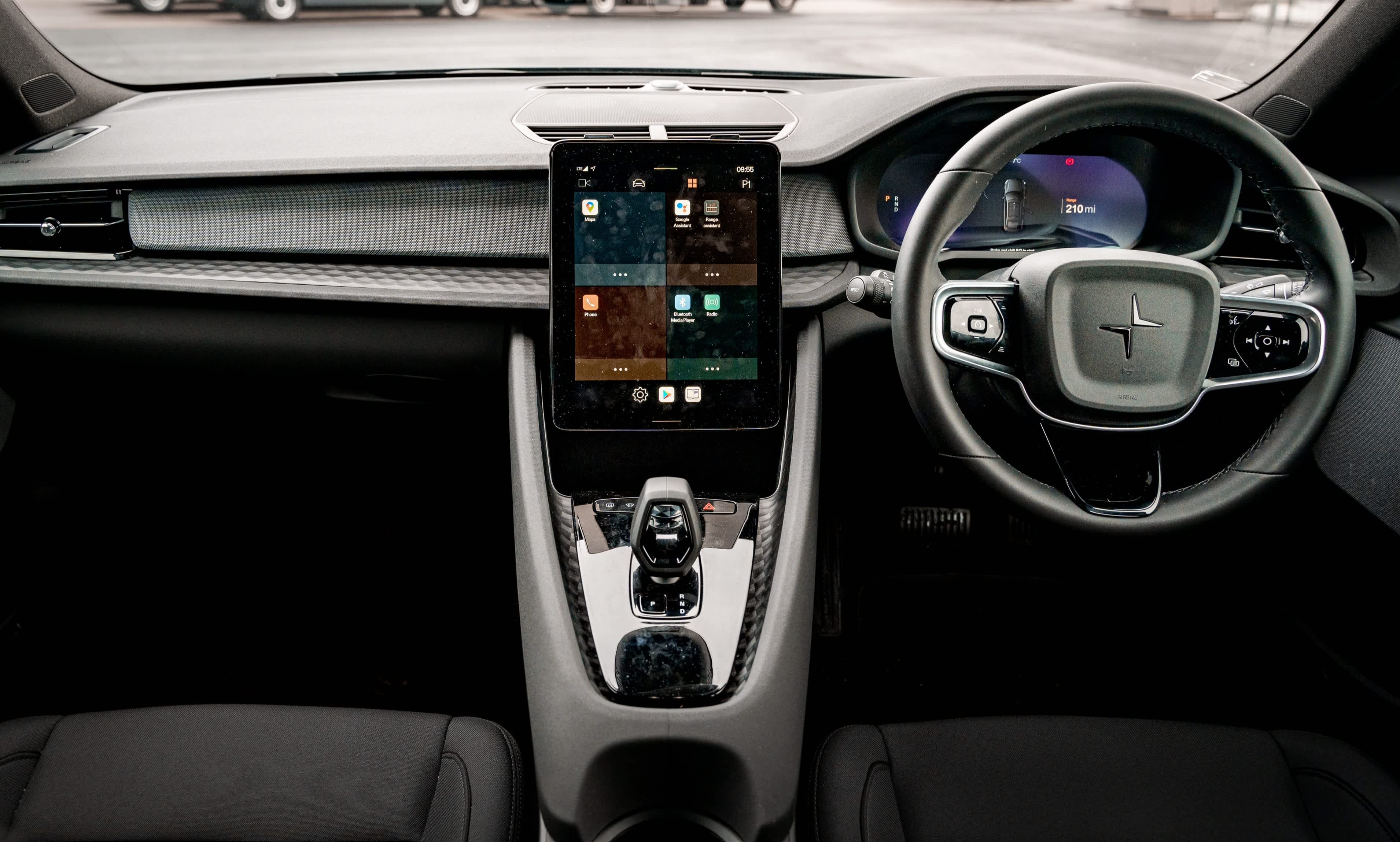With only six years since Google first announced the project, Android Automotive is already set to become the IVI system of choice. Ever since 2020 when the Polestar 2 became the first car equipped with Android Automotive, it’s been catching the attention of the industry as more and more car companies are implementing the system.
In this article, we will examine what Android Automotive has to offer to car manufacturers in detail. Specifically, we’ll go through:
The difference between Android Auto and Android Automotive, and how it relates to Apple CarPlay.
The ways car companies can use the system, and the types of applications that can be installed into it.
The benefits that come with adopting Android Automotive, and the reasons car manufacturers are choosing the system.
Read on to learn all about it.
Android Automotive: the background
First introduced in 2017 as a result of the cooperation between Google and Intel, Android Automotive was created as an OS meant to be used in vehicles able to run Android applications.
What’s important to understand here is that, as Google simply puts it, “Android automotive is Android.” The codebase and repository are the same as in other Android devices such as smartphones or tablets.
With that said Google makes it clear that the OS builds upon Android, with the requirements and features suited specifically for automotive. Google also specifies that it plans to turn Android Automotive into a “full-stack, turnkey automotive infotainment platform”.

Android Automotive system in Polestar 2. Source: Unsplash.
Android Auto vs Android Automotive
Before we get into the gist of what Android Automotive can do, we need to clear up one common misconception.
If you’re familiar with Google’s services for vehicles, you’ve definitely heard of Android Auto. And while it's true that Google made things confusing by choosing such similar names, Android Automotive and Android Auto are in fact two entirely different products.
Created back in 2014, Android Auto is a platform that runs on smartphones, which enables users to project the Android Auto experience on a car’s infotainment system by plugging the phone in via a USB cable. So while Android Automotive is an operating system running in the head unit of a car, Android Auto is just an application.
What's interesting to note is that Google specifies Android Auto is meant for “users who have an Android phone and the Android Auto app but don't have a vehicle that uses Android Automotive OS” – which might hint that Android Auto might be scrapped altogether in favor of Automotive sometime in the future.
Learn the insights of creating apps for automotive systems. Check out our work for McIntosh >>

One important thing to add here is that, because of the confusion with naming, Apple CarPlay is often mentioned as an alternative to Android Automotive. This isn't exactly true: Apple CarPlay is a direct competitor to Android Auto, not Automotive, as it’s a functionality that can be accessed via an iPhone, and not a standalone OS built into the car.
How can car manufacturers use Android Automotive?
There are two ways in which car manufacturers can make use of Android Automotive, and there’s a huge difference between them.
But first, we need some background. As you most likely know already, Android is open-source, with Android Automotive included in the Android Open Source Project (AOSP).
While the AOSP provides the information and source code that makes it possible to create variants of the OS for anyone who wishes to do so, it doesn't give you a production-ready solution. In order to make it such, you need to build upon it and customize it on your own.
Naturally, Google has an answer for this pain point, and it comes in the form of Google Automotive Services (GAS).

It is a paid license package that makes it possible for car manufacturers to use Google’s services (such as Google Play, Google Assistant, navigation in form of Google Maps, etc.) and integrate them into their systems instead of having to create similar solutions themselves.
So when opting for Android Automotive, companies may choose to either:
Create their own variation of the system based on the AOSP.
Make use of the ready-made solution that is GAS.
While making use of GAS is most likely the easiest choice, it is (of course) not a free solution – a fee must be paid in order to obtain the license. Additionally, it would also require using Google’s apps exclusively.
For similar reasons, some have already opted to build their own solutions instead of using GAS – the most recent example being BMW, which recently announced it will be incorporating Android Automotive into its vehicles in the near future, but won’t make use of Google’s paid license.
Types of apps currently supported by Android Automotive
Because of safety restrictions specific to the automotive industry, the types of applications that can be incorporated into Android Automotive are pretty limited. When it comes to the Play Store, there are currently only a little over 30 apps available for Automotive.
The current version of the system as of today is Android Automotive 13, released in 2022, and as of now, it supports the following app categories (as listed by Google):
Audio apps that let users play a variety of audio content inside the car. Google specifies that all media apps have to include a media browser service.
Messaging apps for sending and receiving messages via text-to-speech or voice input.
Navigation apps that provide driving directions. For building navigation apps, the Android for Cars Library is to be used.
IoT apps that make it possible to use connected devices from inside the car. This is a new addition to both Android Auto and Automotive – it should be noted that it allows for only certain types of actions that won’t distract the driver.
Video apps that make it possible to display streaming videos. Those apps are only possible to use while the car is parked, for obvious safety reasons.
With both IoT and video being fairly new additions to the list, it’s expected that Android Automotive will expand the number of apps available for the platform in the near future.
Choosing Android Automotive: the benefits for car manufacturers
As of now, several major players have chosen to adopt Android Automotive in their vehicles including Volvo, Honda, General Motors, Renault–Nissan–Mitsubishi Alliance, Ford, and most recently BMW.
Here, we’ll take a closer look at what they – and other car manufacturers that most likely will follow – have to gain by choosing the system.
It’s familiar

Whether the choice is to use GAS or not, one common benefit still remains: the entire system is part of the Android Open Source Project. By using a commonly known OS, car manufacturers can reduce the time to develop their in-car entertainment systems, even if they opt for building their own system based on AOSP.
Android Automotive will be quite easy to comprehend for developers who are already used to develop devices using the standard Android OS – there’s no need to reinvent the wheel, which is very convenient for automotive companies.
It’s also a matter of familiarity from the user’s point of view, as we’re talking about an interface that many are already accustomed to using on their smartphones, which makes it easier for people to learn to navigate the system.
It’s flexible

Google makes a case for Android Automotive being customizable and for good reason. Giving companies the choice to create their own infotainment system on top of the AOSP means the freedom to implement their own services, without the need to start everything from scratch.
While most of the car manufacturers that chose Automotive opted for the GAS option, the list of those that are willing to build their own Android Automotive-based systems keeps growing, with the aforementioned BMW being the most recent among them.
It’s Google

The possibility to integrate the infotainment systems with a range of Google’s applications, including those especially beneficial for driving, is, unsurprisingly, a very attractive offer.
Take Google Maps as the most prominent example. It’s no secret that the app is by far the most popular navigation solution among drivers, and by a long margin at that. And with Android Automotive, drivers get native support for Google Maps, Google Assistant, and other Google applications, without the need to use a smartphone.
Automotive also gives Google an opportunity to adjust its flagship apps to the car system specifically and improve on what’s already there for drivers. A good example of this is the recent announcement of Google launching its new HD maps made for the operating system (which, of course, will be available for OEMs who choose to use GAS.)
It’s here to stay

Aside from everything else, Google’s offer is attractive to car companies because by utilizing Android Automotive, they can take advantage of a readily available operating system for their vehicles with a guarantee of regular software updates – including ensuring that the system remains up-to-date with new wireless standards.
It's no surprise then that according to predictions, Android Automotive is set to grow even more rapidly in the coming years. S&P Global Technology Feature Benchmarking predicts that the next few years will be crucial for Android Automotive’s growth, and is expected to capture around 18% of the market share by 2027 (with an additional forecast of around 80% of Volvo’s cars would have the systems equipped by then).
With an increasing number of manufacturers choosing it, including Honda and Ford as the more recent, the future is looking bright for Google.
Summary
Android Automotive is quickly establishing itself as one of the biggest players of car infotainment. The system gives car manufacturers both flexibility (with the option to obtain a GAS license or build a system on top of the AOSP) and the convenience that comes with using a regularly updated system from a well-known provider.
With new additions such as the recent introduction of IoT apps into the system, Android Automotive may soon become the most relevant IVI on the market.
Starting a tech project related to the automotive industry? Get in touch with us; we'll advise you on the best design and development options for your case.

Luiza Stelitano
Senior Content Specialist

